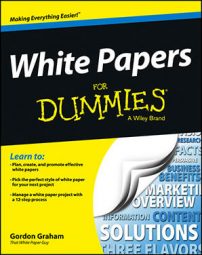Many white papers don’t turn out well, often because they’re missing some key structural elements or they weren’t planned properly from the start. Fortunately, if you identify these issues in time, you can save your white paper from being passed over by any prospects.
Boring, nondescript white paper titles
Many potential B2B buyers first encounter your white paper as a short snippet in a list of search results with only its title to go by. How can a white paper with a boring title ever get noticed? You have to keep the title lively by doing some of the following:
Use active verbs and numbers.
Include the benefits to the reader.
Pitch it to a specific job title.
Suggest that it offers inside information, tips, or gotchas that readers need to know.
Add urgency with time-specific words, like now or today.
Don’t just slap an intriguing title on a tired, worn-out document. Instead, use the freshest research and the perfect recipe to whip up a white paper of the ideal flavor.
No summary at the start of your white paper
Just about every executive today has too much to read, too much to remember, too much to do, and too much to think about. A white paper that doesn’t ease into the content is like a pushy waiter who starts serving up ice-cream sundaes before even showing you the dessert menu.
Be polite. Help your readers decide in advance whether your white paper is what they want by providing an introduction, abstract, overview, or executive summary at the very start. In other words, “tell them what you’re going to tell them.”
Give them a one-page summary with a brief recap of the key points covered in your white paper. They’ll likely scan that much and then decide whether to go on. And even if they don’t, at least you get your argument in front of them in a nutshell.
No conclusions at the end of your white paper
Echoing your summary at the start, every white paper should include some brief conclusions at the end. Providing an introduction at the start and conclusions at the end are well-established conventions in many forms of communication. These elements apply perfectly well to white papers, too.
In the executive summary, you tell your readers what you’re going to tell them; in the main body, you tell them; and in the conclusions, you tell them what you told them.
The conclusions are especially useful for busy executives who flip to the back of your document to see “the bottom line.” If you repeat your key take-away messages in a few short sentences at the end, that doubles the chances that those messages will get through.
Not the right length for a white paper
Your white paper should make an impression in the first two or three pages. But that doesn’t mean a two-page flyer will make an effective white paper. Such a short document doesn’t have enough room to deliver the kind of depth needed in a backgrounder or problem/solution. If you do a short numbered list of a page or two, it’s more realistic to call it an “article” or “blog post.”
For most business people, five to six pages in the main body is about the right length for a backgrounder or numbered list. This length is enough to deliver your message, especially if you format it to be easy to scan.
Use white space, bullets, tables — anything to break up the solid wall of gray text. For a backgrounder, technical people can often tolerate a longer white paper that offers more detail, even up to 25 or 30 pages. But in a problem/solution, if you run on much longer than 10 or 12 pages, you can lose a lot of your audience.
You can sidestep this problem by breaking up longer documents into separate white papers of five or six pages apiece, each on a more focused topic. Doing so gives you an added benefit: You get two or more chances to reach your target audience.
No logical flow of ideas in your white paper
To help a problem/solution white paper linger in the mind, you need an effective flow of ideas. If your white paper has no overall design to hold it together, few readers will find it compelling or memorable, especially if they “read” with a typical skim-scan-and-skip approach.
Try one of the following tried-and-true methods for building a logical argument:
Start with the known, and then delve into the unknown.
Start with the past, describe the present, and project into the future.
Start with an overview and drill down to the details.
Start with the most important and move to the least important.
Start at the beginning of a process and follow it step by step to the end.
A backgrounder or a numbered list can be more modular, with less need for a tight logical argument connecting A to B. You can’t afford to skip around randomly. You need to use the same level of detail throughout. Your readers can absorb your points better when you express each section or numbered point with a parallel structure. Find an appropriate logical structure and stick to it.

